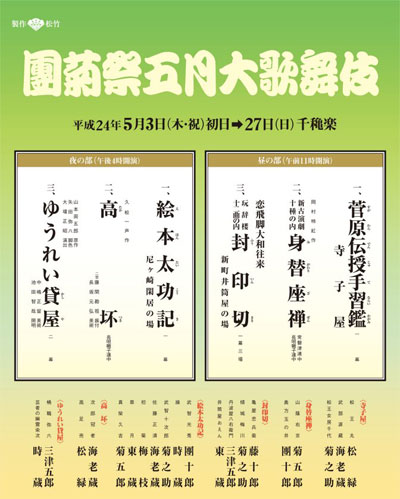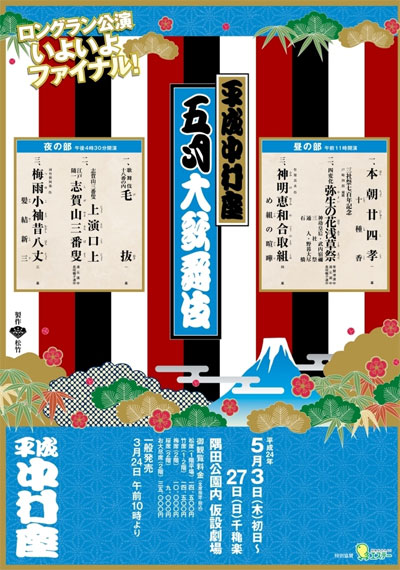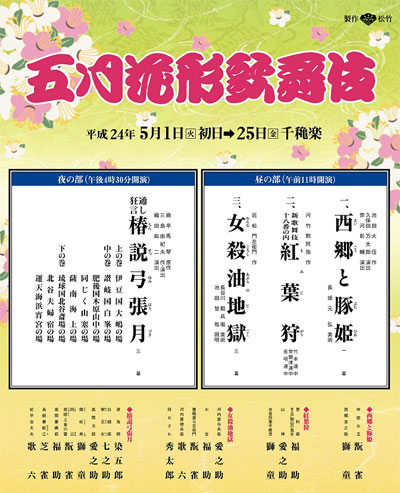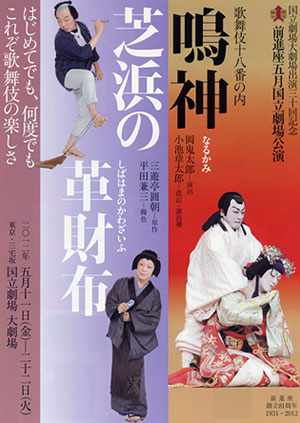| Comments |
Last month of performances for the Heisei Nakamuraza 7-month project, a temporary theater built within the Sumida Park in T˘ky˘
in the popular district of Asakusa. The 700th anniversary of the Sanja Matsuri is celebrated through the staging of the hengemono
"Yayoi no Hana Asakusa Matsuri"!
Jusshuk˘: Princess Yaegaki is mourning the death of his fiance Katsuyori,
but as she burns incense in his memory, she notices the resemblance between the new gardener and her fiance's portrait.
The gardener is in fact Katsuyori, who has entered the household of Yaegaki's father to regain the
possession of a stolen family treasure, a famous helmet, with the help of Nureginu, a woman who also mourns for the man that died
in the place of the real Katsuyori. Unfortunately, Yaegaki's father has also seen through the disguise and plans to kill Katsuyori.
The role of Princess Yaegaki, one of the most important onnagata roles,
is played by Nakamura Shichinosuke, supported by Nakamura Senjaku, Nakamura Kankur˘ and Band˘ Yajűr˘ in the roles of Katsuyori, Nureginu and Nagao Kenshin.
Asakusa Matsuri: in the Edo period,
there were virtuoso sets of dances with one actor changing from character to character
with a series of spectacular quick changes (hengemono).
This is a set of four dances, all featuring Ichikawa Somegor˘ and Nakamura Kankur˘ in a series of roles.
It begins in the ancient past with Empress Jing˘ and her aged minister Takeuchi Sukune.
It is said that the empress delayed the birth of her child, the emperor,
so that she could conduct an attack on the Asian continent.
Then the scene changes to the exuberant Sanja festival and shows two
fishermen who discover a sacred statue in a river. Suddenly, the fishermen are
possessed by the spirits of Good and Evil and dance vigorously.
The scene switches to the pleasure quarters with two patrons, a sophisticated
urban playboy and a clumsy unfashionable man. Finally it ends on a fantastic note
with the two dancers as lion spirits.
Megumi no Kenka: they used to say that fights and fires were the
flowers of the city of Edo and many plays feature the gallent members of
firefighting troupes, who were popular heroes. This particular play depicts a
rivalry between the members of the Megumi firefighting band and a group of
sum˘ wrestlers, which ultimately is
a confrontation between the firefighters, who represent the commoner class and
the samurai patrons of the sum˘ wrestlers.
The fight begins with a minor incident, but grows into a situation of such tension,
that when Tatsugor˘, the leader of the firefighting gang, goes to his final fight,
he goes with the full intention that this may be a fight to the death.
Before he leaves, he has an emotional parting from his family.
Starring Nakamura Kanzabur˘ as Tatsugor˘ and Nakamura Hashinosuke as the
leader of the group of sum˘ wrestlers.
Featunring also Nakamura Baigyoku, Nakamura Senjaku, Nakamura Kinnosuke, Band˘ Hikosabur˘, Kataoka Kamez˘, Ichimura Manjir˘ and Nakamura Kankur˘.
Kenuki: in this play, which retains the light, festive atmosphere of
early-period Kabuki, a princess has a mysterious ailment that makes her hair stand
on end, an ailment that prevents her from carrying out her long-awaited marriage.
Kumedera Danj˘ comes from the groom's household to investigate and finds a plot
to take over the household when his tweezers float in mid-air.
Nakamura Hashinosuke stars in a play that features the bombastic aragoto
style of acting that is normally a specialty of the Naritaya guild.
Featuring also Nakamura Senjaku, Nakamura Kinnosuke, Kataoka Kamez˘, Band˘ Hikosabur˘ and Ichimura Manjir˘.
K˘j˘/Shigayama Sanbas˘: there is a close relationship between audience and actors in Kabuki and
the actors often speak directly to the audience. In this case the stage announcement is by Nakamura Kanzabur˘,
the head of the troupe to explain the origins of this dance and how important it is for the Nakamura family of
actors since one of the most famous and important members of the Nakamura family, Nakamura Nakaz˘ I,
was famous as a dancer in the Shigayama style. Based on the ritual play "Okina" in the N˘ theater, the "Sanbas˘"
is both an important prayer for prosperity and a vigorous dance. This particular version retains features of one of the oldest styles of Kabuki dance,
the Shigayama style and is also known as "Shitadashi Sanbas˘" (The sanbas˘ with his Tongue Sticking Out)
takes its title from the sanbas˘ (Nakamura Kankur˘) sticking his tongue out.
Some say that this is from absorption in the joy of his dance. Others say that this is an auspicious sign.
In any case, this vigorous and joyful dance is exhilarating to watch.
Kamiyui Shinza: Shinza is a barber that goes from door to door, but at
the same time, he is a villain that kidnaps Okuma, the beautiful daughter of a
wealthy household, and even resists the efforts of Yatagor˘ Genshichi, the most
prestigious strongman in town, to get her release. Starring Nakamura Kanzabur˘ as Shinza,
Band˘ Shingo as Okuma, Nakamura Baigyoku as Chűshichi, Nakamura Hashinosuke as Ch˘bŕ and Band˘ Yajűr˘ as Yatagor˘ Genshichi.
Source: Earphone Guide website
|



